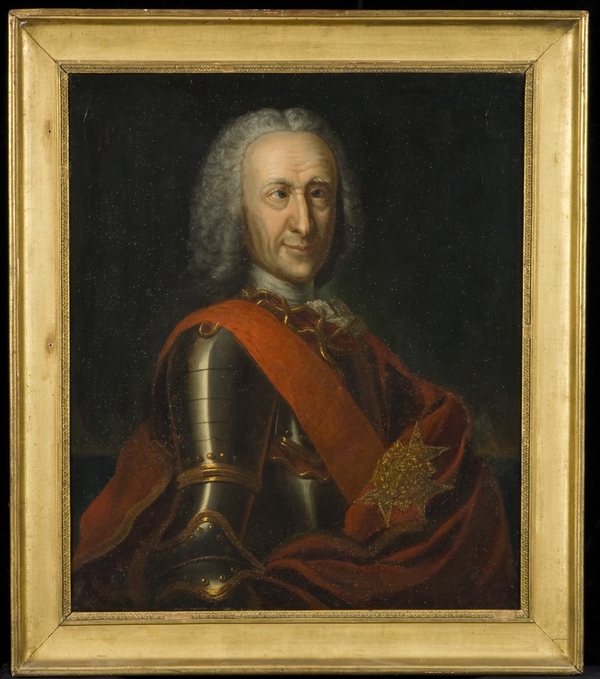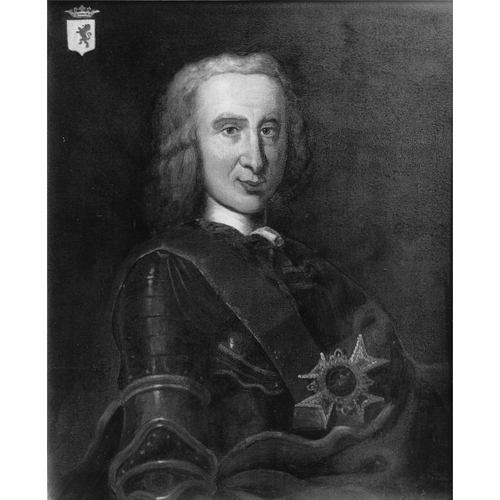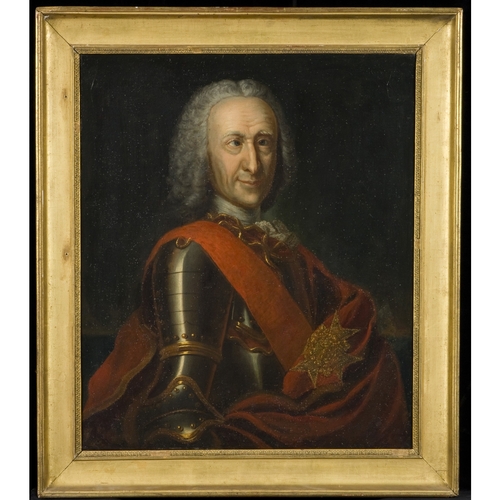
Source: Link
RIGAUD DE VAUDREUIL, FRANÇOIS-PIERRE DE, soldier and administrator; b. 8 Feb. 1703 in Montreal, son of Philippe de Rigaud* de Vaudreuil, governor general of New France, and Louise-Élisabeth de Joybert* de Soulanges et de Marson; d. 24 Aug. 1779 at the Chateau de Colliers, in the commune of Muides (dept of Loir-et-Cher), France.
François-Pierre de Rigaud de Vaudreuil, whom Canadians called “Monsieur de Rigaud,” belonged to an old family from the province of Languedoc; the Armorial de France enumerates 11 generations prior to 1680 of the Rigauds whose descendants won fame on Canadian soil. Philippe de Rigaud de Vaudreuil, who landed at Quebec in 1687, served in the army and assumed the office of governor general of New France in 1703, retaining it until 1725. His six sons were active in the king’s service, holding posts in the army, the navy, and the colonies.
The fifth son, François-Pierre, was born the year his father became governor general. Nothing is known of his childhood, or of his education, which must, however, have been rudimentary since his contemporaries, while considering him brave, also said that he was “shallow-brained” and “unintelligent.” Taking advantage of the Comte de Pontchartrain’s influence, his father had him appointed at the age of five to the company of gentlemen midshipmen, despite the regulation that candidates be 18. He obtained a post for him as ensign in the colonial regulars in 1712 and a lieutenancy on 2 June 1720; his mother, who lived at Versailles from 1709 to 1721, also had a hand in these appointments. The young lieutenant was initiated into military life by serving as adjutant. He first visited France in 1723, and the following year obtained command of a company, again through the influential patronage which the Vaudreuils enjoyed at court. In 1726 he returned to Canada, but went back to France to settle his father’s estate two years later; he revisited it in 1730 and 1731. According to Canon Pierre Hazeur de L’Orme, who was continually on the look-out for gossip from the colony, Rigaud de Vaudreuil went to France to see Louise, the daughter of Joseph de Fleury* de La Gorgendière and Claire Jolliet, whom he had found attractive. He came back to Quebec in 1732 on the Rubis, and the following year on 2 May was married in Quebec. He and his wife had five children, all of whom died in infancy.
Rigaud de Vaudreuil was not of the generation that had taken root in Canada, but rather of the one that became Canadian. A soldier, fur-trader, and seigneur, he was typical of that Canadian oligarchy which, though serving the king, endeavoured to work for Canada and for its own interests, a practice which led to frequent clashes with people who came from the mother country. From 1724. the year in which he obtained a company, until 1741, when he was appointed major, Rigaud de Vaudreuil had an inconspicuous role and concentrated mainly on his own promotion and interests. In 1732, in joint ownership with his brother Pierre de Rigaud de Vaudreuil de Cavagnial, he obtained the seigneury of Rigaud adjoining their seigneury of Vaudreuil on the Ottawa River. In 1736 he secured the grant of the seigneury of Saint-Joseph-de-la-Nouvelle-Beauce, with a responsibility which the other local seigneurs shared of seeing to the construction of “a good carriage road.” His obligations as a seigneur did not lie heavily upon him; Rigaud de Vaudreuil was no gentleman farmer.
The post of major which he obtained in 1741, and then the War of the Austrian Succession, finally gave him a chance to put his military talents to best use. Although the war occasioned massive deployments of armies in Europe, in America the Canadians stuck to skirmishing; no fewer than 27 raids spread terror in New England. Rigaud de Vaudreuil was given the responsibility of protecting Fort Saint-Frédéric (near Crown Point, N.Y.). Arriving at the fort in August 1746, and finding no British troops in the vicinity, he followed the Kaskékoué (Hoosic) River to Fort Massachusetts (Williamstown, Mass.), which he razed to the ground after a faint show of resistance by its defenders. On the way back he burned some 200 buildings along the Kaskékoué; he was in Montreal by 26 September. In June 1747 he returned with 780 men to Fort Saint-Frédéric, where he waited in vain for the British; he did not organize any offensive on his own.
In September of that year the new commandant general, Roland-Michel Barrin* de La Galissonière, brought the news of the end of hostilities in Europe. The treaty of Aix-la-Chapelle in 1748 restored peace to Europe but established only a truce in America, where the frontiers of Acadia and the Ohio region were the locations of a bitter struggle marked by constant skirmishing; La Galissonière endeavoured to fortify the strategic points on the frontiers. That year Rigaud de Vaudreuil was named king’s lieutenant in the Government of Quebec, a prestigious post placing him at the centre of Quebec society. In September he obtained a seigneury on the Yamaska that would later be the site of the town of Saint-Hyacinthe (Que.).
On 1 May 1749 Rigaud de Vaudreuil succeeded Claude-Michel Bégon* de La Cour as governor of Trois-Rivières. He was thus in a good position to engage in the fur trade; he obtained a grant for two years of the post of Baie-des-Puants (Green Bay, Wis.), receiving the permanent concession in 1759. He sailed for France in 1754, and on the return voyage the following year his ship, the Alcide, strayed from the convoy off Cape Ray, Newfoundland, and British ships under Vice-Admiral Edward Boscawen* forced it to surrender after a broadside that raked it “from top to bottom at point-blank range.” Rigaud de Vaudreuil was captured and taken to Halifax where, unsuspecting, he handed over precious documents about Louisiana to Thomas Pichon, a spy in the pay of the British. Subsequently he was interned in England; he succeeded in getting over to France and then on 4 May 1756 returned to Quebec.
By June France and Great Britain had declared war, thus making official the state of war that existed on the frontiers of New France. Upon his arrival Rigaud de Vaudreuil was called into service. During the summer he commanded the advance guard of the forces under Montcalm*, who on 11 August invested the forts in the region of Oswego (N.Y.). Following bombardments and a three-day siege, the British capitulated. Though Montcalm took the credit for it, this splendid feat of arms nevertheless established the reputation of the Canadians and of Rigaud de Vaudreuil. In February and March 1757 he commanded an expeditionary corps of 1,500 including, it seems, 600 Canadians and 300 Indians, which went across country to ravage the region around Fort George (also called Fort William Henry; now Lake George, N.Y.), destroying the depots and the boats which were to have supported an invasion of Canada.
Since the death in January 1755 of the governor of Montreal, Charles Le Moyne* de Longueuil, a successor had been sought for his post. Traditionally the governor of Trois-Rivières replaced the governor of Montreal, and Governor General Pierre de Rigaud de Vaudreuil de Cavagnial proposed his brother. But the minister hesitated, since he did not consider François-Pierre sufficiently talented and intelligent to take the place of the governor general, should the need arise. Vaudreuil insisted, skilfully pleading his brother’s cause and that of the Canadians, who had always been relegated to minor posts. On 1 May 1757 the minister assented. Rigaud de Vaudreuil assumed his duties as governor from that date. He had to quarter troops, supply them, and ensure the defence of the region. In 1758 he carried out diversionary manœuvres while Montcalm, with the main body of troops, stopped the invaders at Carillon (Ticonderoga, N.Y.). In 1759, during the Quebec campaign, the governor of Montreal was busy strengthening the line of defence along the Richelieu, which had its strong points at La Prairie and l’île aux Noix, seeing that the crops were harvested and maintaining the roll of men fit for military service. After the fall of Quebec, Montreal became the capital of Canada; there, on Place Jacques-Cartier, Governor General Vaudreuil set up headquarters. There was no longer any reason for Montreal to have a governor of its own; Rigaud de Vaudreuil faded into the background at the moment New France was becoming part of history.
Then came life in exile. A British vessel carried Vaudreuil and Rigaud and their suite to France. The two brothers, who were close friends, lived in Paris and at Muides at the Château de Colliers. In March 1762 Rigaud de Vaudreuil, who was called the Marquis de Rigaud in France, obtained an annual pension of 2,000 livres, which he tried on several occasions to have increased. He died on 24 Aug. 1779. His wife had died in February 1775 in Saint-Domingue (Hispaniola), where she had gone with her niece.
[François-Pierre de Rigaud de Vaudreuil left no personal records. His correspondence and papers are dispersed throughout the major documentary series on the French regime. For his career we have used principally documents published in ANQ Rapport, PAC Report, BRH, Coll. des manuscrits de Lévis (Casgrain), and NYCD (O’Callaghan and Fernow).
A secondary figure, Rigaud de Vaudreuil has had little attention from historians. He has, however, been the subject of a master’s thesis: Bernard Vinet, “François-Pierre Rigaud de Vaudreuil, 1703–1779” (université de Montréal, 1954). The thesis is now outdated, but its chronological framework has been useful. In addition there is material on Rigaud de Vaudreuil in various historical works: Æ. Fauteux, Les chevaliers de Saint-Louis; Frégault, La guerre de la Conquête, which has interesting pages on his role at forts Oswego and George and on the question of the appointment of Canadians to high administrative posts; Ernest Gagnon, Le fort et le château Saint-Louis (Québec); étude archéologique et historique (Montreal, 1925); Francis Parkman, A half-century of conflict (5th ed., 2v., Boston. 1893); Benjamin Sulte, “Les gouverneurs des Trois-Rivières,”BRH, II(1896),66–72. j.h. and j.r.]
Cite This Article
Jean Hamelin and Jacqueline Roy, “RIGAUD DE VAUDREUIL, FRANÇOIS-PIERRE DE,” in Dictionary of Canadian Biography, vol. 4, University of Toronto/Université Laval, 2003–, accessed January 19, 2026, https://www.biographi.ca/en/bio/rigaud_de_vaudreuil_francois_pierre_de_4E.html.
The citation above shows the format for footnotes and endnotes according to the Chicago manual of style (16th edition). Information to be used in other citation formats:
| Permalink: | https://www.biographi.ca/en/bio/rigaud_de_vaudreuil_francois_pierre_de_4E.html |
| Author of Article: | Jean Hamelin and Jacqueline Roy |
| Title of Article: | RIGAUD DE VAUDREUIL, FRANÇOIS-PIERRE DE |
| Publication Name: | Dictionary of Canadian Biography, vol. 4 |
| Publisher: | University of Toronto/Université Laval |
| Year of publication: | 1979 |
| Year of revision: | 1979 |
| Access Date: | January 19, 2026 |




